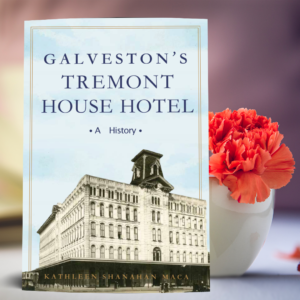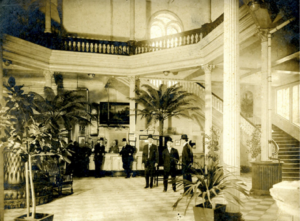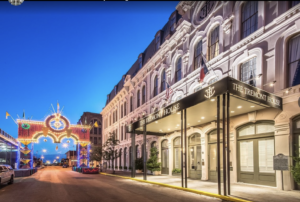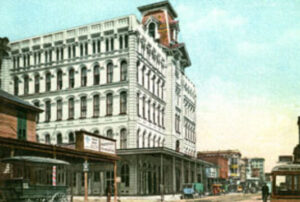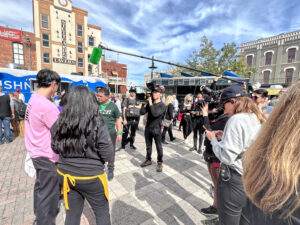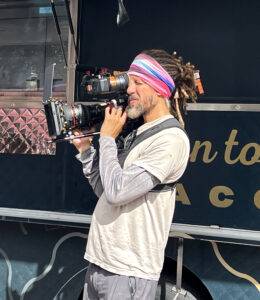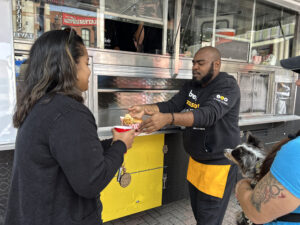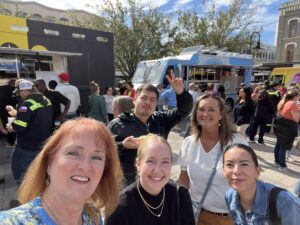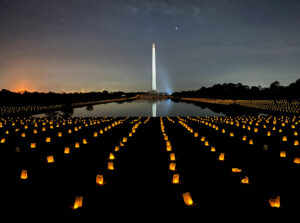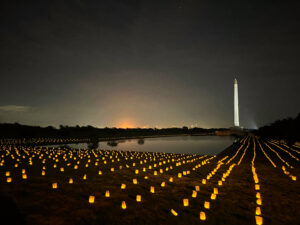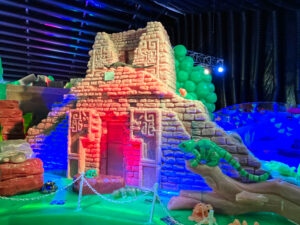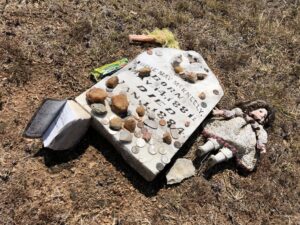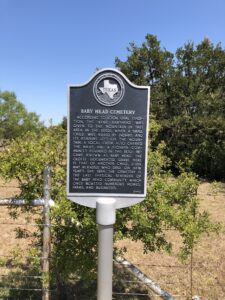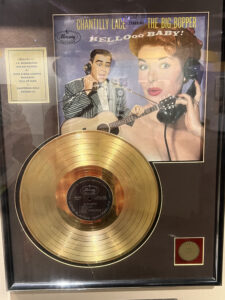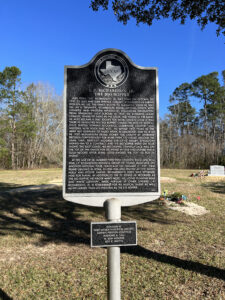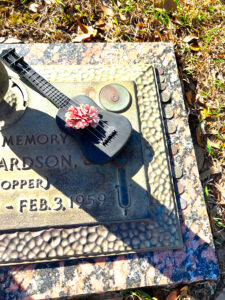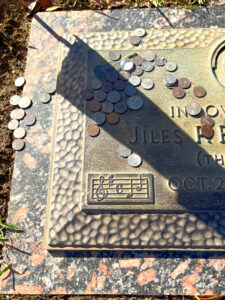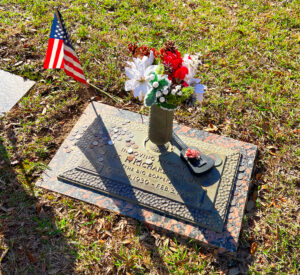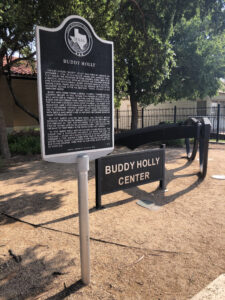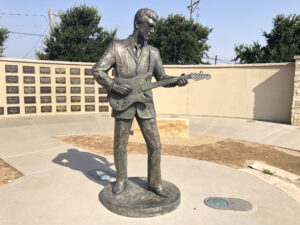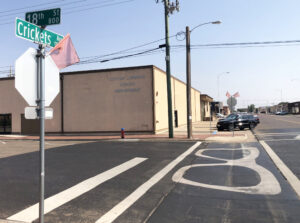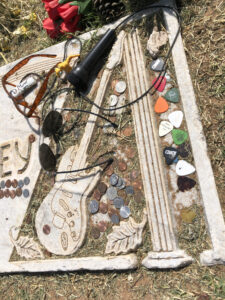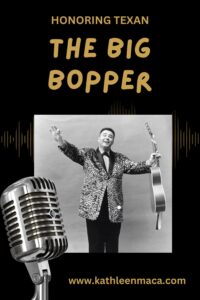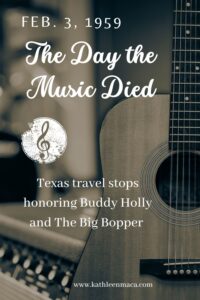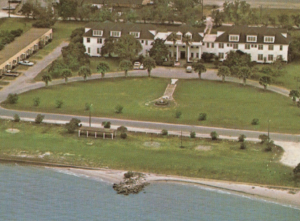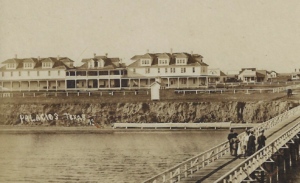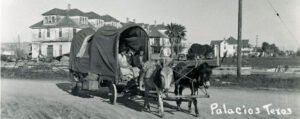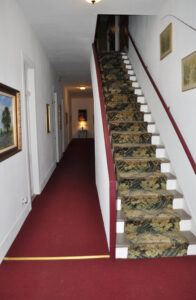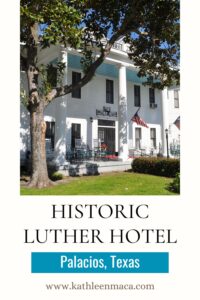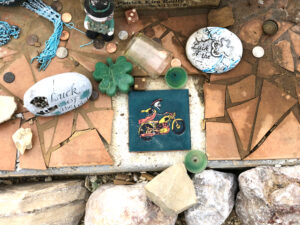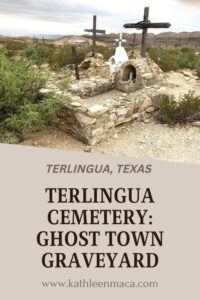Author: admin
Great Food Truck Race: Galveston Edition
Do you watch Food Network’s show The Great Food Truck Race with Tyler Florence?
Teams from around the country operate food trucks in a winding string of cities, advancing to the next round of competition each week by how much the trucks earn. It’s fun to watch, and today…it was fun to watch them film in Galveston, too!
The trucks parked in Saengerfest Park on The Strand downtown, and began serving at 11 a.m. Each truck had a film crew assigned to them to capture the action – good and bad.

 When I saw that the array of food included Mexican and Cajun food and seafood, all I could think was “They better have really brought their “A” game.” Galvestonians are a food-loving bunch, and these dishes are regular “food groups” there.
When I saw that the array of food included Mexican and Cajun food and seafood, all I could think was “They better have really brought their “A” game.” Galvestonians are a food-loving bunch, and these dishes are regular “food groups” there.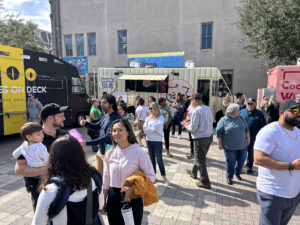
The crowd wasn’t disappointed. The cooks running the trucks were spirited and enjoyable, despite the pressure of the competition, and the dishes got a round of thumbs-up from everyone I talked to – which is high praise.
As the lunch hour approached, the lines got longer and some of the trucks simply couldn’t keep up the pace.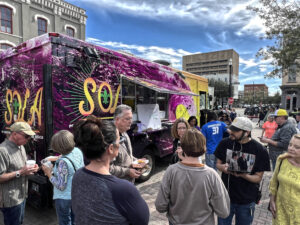
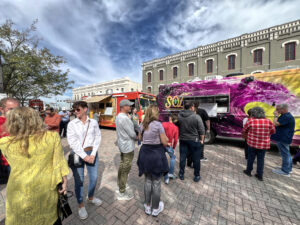
Others sold out of product and had to make a mad dash to the nearest grocery. If you watch the show, you’ll know that this is one of the biggest “oh no’s” of a day of competition because it causes a truck to miss precious hours they are allowed to serve.
Pups even came with their owners, hoping that something would drop within their reach.
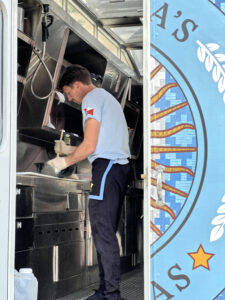
 By 2:30 p.m. (I think they were only allowed to serve until 3:00), half of the trucks were sold out.
By 2:30 p.m. (I think they were only allowed to serve until 3:00), half of the trucks were sold out.
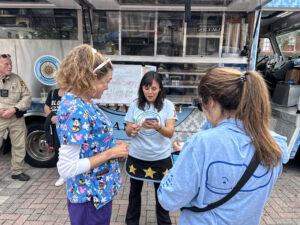 We’ll have to wait until the new season airs to see who makes it to the next round…and eventually wins. If you have a favorite television show that films on the road, be sure to check their website. Travel schedules are often posted, letting you join in the fun.
We’ll have to wait until the new season airs to see who makes it to the next round…and eventually wins. If you have a favorite television show that films on the road, be sure to check their website. Travel schedules are often posted, letting you join in the fun.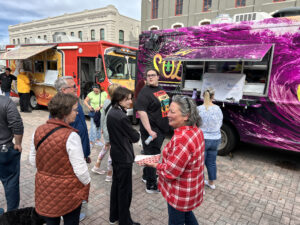
Thanks to Chef Tyler and the Food Network for bringing the trucks to Texas and Galveston – hope to see you again soon!


Fields of Honor
Last night we ventured to the San Jacinto Battleground to witness the grounds being softly illuminated by over 21,500 luminarias.
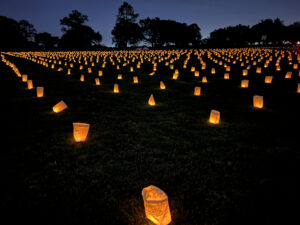
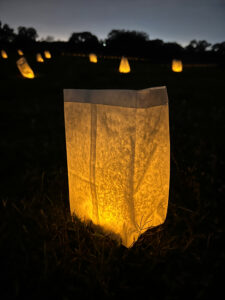 Each candle represented a Texan lost in battle from the Texas Revolution through the war in Afghanistan.
Each candle represented a Texan lost in battle from the Texas Revolution through the war in Afghanistan.
In the Texas Revolution alone, 1,700 Texans perished.
Over 100 volunteers laid the luminarias out along a three-mile-long trail and grounds. Photos simply can’t capture how beautiful, moving and humbling the experience was.
Simply stunning.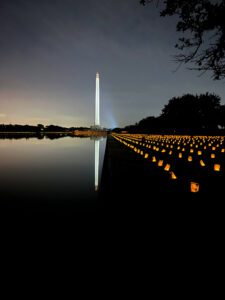
Moody Gardens Ice Land: Rainforest Holiday
Get set for the “coolest” way to add holiday fun to your calendar in Galveston!
A team of skilled ice carvers from Harbin, China (home of the International Ice and Snow Sculpture Festival) has spent 45 days and over 1,100 hours in an enormous tent kept at a brisk 9 ° Fahrenheit, carving over two million pounds of ice into a tropical themed wonderland. It’s the only rainforest you’ll ever visit that will have you thankful to pull on a complimentary parka!
 From the minute you walk through the doors, you’ll be immersed in a magical icy forest filled with plants, trees, creatures and a few Christmas-y surprises.
From the minute you walk through the doors, you’ll be immersed in a magical icy forest filled with plants, trees, creatures and a few Christmas-y surprises.
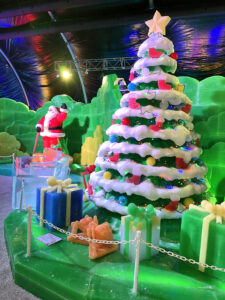 Even the adults will get in line to go down the ice slide…you better believe I did!
Even the adults will get in line to go down the ice slide…you better believe I did! 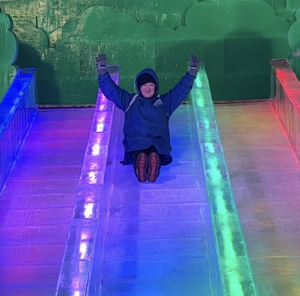
Shivers Ice Bar is a great – and adventurous – way for grown-ups to wrap up their visit, sipping adult beverages while sitting on benches and at tables made of blocks of ice.
What to expect:
Detailed carvings of tropical plants and adorable animals
A festive Santa scene, complete with ice tree
A winding ice tunnel
Shivers Ice Bar for adults
Photo opps galore
A uniquely Galveston experience
Bring your gloves, caps, warm sock and shoes – Moody Gardens will provide the parkas. Open November 18, 2023 through January 6, 2024.
While you’re planning your visit, be sure to check out Moody Gardens other holiday offerings, including the Festival of Lights, train rides along the trail, breakfast with Santa, holiday buffets, holiday theme 3D and 4D films, fireside s’mores and a brand new family-friendly variety show, – “Christmas Wish: A Holiday Spectacular.”
For details and tickets, visit www.moodygardens.org
Babyhead Cemetery Legend
Happy October!
Especially around Halloween, folklore seems to become more popular and tales that hint of gruesome details are told and retold.
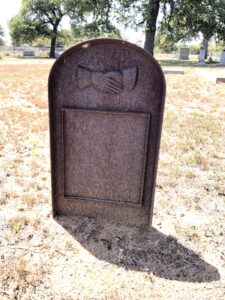 Such is the fate of the origin of Babyhead Cemetery in the Texas Hill Country. Now admittedly when you put those two words together a gruesome backstory seems to be guaranteed. I’ll let you decide.
Such is the fate of the origin of Babyhead Cemetery in the Texas Hill Country. Now admittedly when you put those two words together a gruesome backstory seems to be guaranteed. I’ll let you decide.
The cemetery is about ten miles north of Llano, in an area where the town of Babyhead once stood, by a mountain of the same name. In the mid-1800s it was a respectable size settlement, with a school, post office, courthouse and a few businesses. It eventually faded away and became a ghost town, with the remaining few citizens being absorbed into the city of Llano.
All that’s left of the community is a cemetery. Babyhead Cemetery. A place visited by more ghost enthusiasts than historians.
The Story
Local tradition shared that the town got its name in the 1850s, when a small child was kidnapped and killed by Indians trying to discourage settlers. Most versions include the grisly detail that the child’s head was left on a stake at the base of the mountain as a warning. Legend has it that the town was named in her memory.
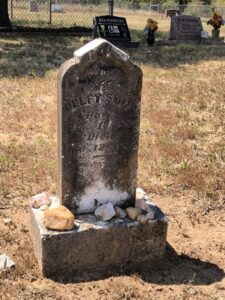 The cemetery today has a few dozen well-kept but weathered graves that date from the early 2000s back to the oldest – that of a child named Jodie May McNeely who died on New Year’s Day in 1884.
The cemetery today has a few dozen well-kept but weathered graves that date from the early 2000s back to the oldest – that of a child named Jodie May McNeely who died on New Year’s Day in 1884.
Now we all know the old game of “telephone” or “post office” where one person says something, the next repeats it but a few facts change and so on. That’s how most local legends take shape.
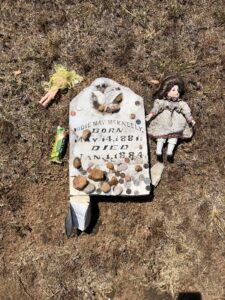 Young Jodie’s grave is the one many visitors associate with the grim story, and that’s where they leave remembrances…dolls, toys, cards, candy…all for the child who they associate with the tale of another child who lost her life much too soon.
Young Jodie’s grave is the one many visitors associate with the grim story, and that’s where they leave remembrances…dolls, toys, cards, candy…all for the child who they associate with the tale of another child who lost her life much too soon.
But at least Jodie is being visited.
A Texas State Historical marker was placed at edge of the cemetery in 1991 that shares a brief version on the story.
Another Option
Unless it was a community of ghouls, it would be very strange indeed to name your town, post office and even your children’s school Babyhead if the event truly occurred.
There is a large creek that runs past the former townsite. Remember that a moving body of water is referred to as a “head.” Unusually, this site also has a smaller creek that runs toward it nearby, right where Babyhead Road is today.o m
Hmmmm…..so if the major water was referred to as the Head, perhaps the settlers referred to the smaller creek as the Baby Head. Seems to make sense to me.
But legends and offerings persist, and really…who knows? You’ll have to decide for yourself.
Would you visit a cemetery named Babyhead?
Galveston’s Tremont House & the 1900 Storm
Coincidence? Perhaps.
 This morning my first thought was that I need to tackle the final draft of the chapter about the 1900 Storm for my upcoming book, History of Galveston’s Tremont House. And no, it actually didn’t occur to me until a couple of hours into work that today is the anniversary of that terrible hurricane.
This morning my first thought was that I need to tackle the final draft of the chapter about the 1900 Storm for my upcoming book, History of Galveston’s Tremont House. And no, it actually didn’t occur to me until a couple of hours into work that today is the anniversary of that terrible hurricane.
 About 1,000 people crowded into the Tremont to find shelter during the storm, and luckily all survived. Thousands of other people were not so lucky.
About 1,000 people crowded into the Tremont to find shelter during the storm, and luckily all survived. Thousands of other people were not so lucky.
The Thomas Edison film (isn’t it amazing that there is footage?!) entitled ‘Panoramic View of Tremont Hotel Galveston’ was taken in the aftermath, and shows the large structure still standing amid surrounding devastation. It’s the tall white building with narrow windows at the end of this clip. (Click below to view)
I’m looking forward to sharing this and other amazing tales in the History of Galveston’s Tremont House when the book releases in the first part of 2024.
Texas Ties: The Day the Music Died
A turning point in rock and roll history that Don McLean sang about in his song American Pie has strong ties to Texas. It was the “Day the Music Died,” when rock legends Buddy Holly, Ritchie Valens and Jiles Perry Richardson – better known as “The Big Bopper” – were lost in a tragic plane crash.
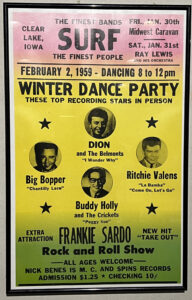
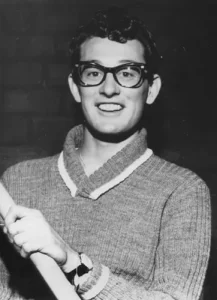 Richardson, Valens and Holly were performing on a concert tour called the “Winter Dance Party,” that started in January 1959 with Dion and the Belmonts. It wasn’t very well organized and the musicians traveled from town to town in a reconditioned school bus – remember the ones with no heating? It wasn’t a great time of year to be traveling in one of those! The bus was so cold that the men often huddled together under blankets to share warmth. Holly’s drummer Carl Bunch suffered frostbite on his feet and had to miss the performance that would be Holly’s last.
Richardson, Valens and Holly were performing on a concert tour called the “Winter Dance Party,” that started in January 1959 with Dion and the Belmonts. It wasn’t very well organized and the musicians traveled from town to town in a reconditioned school bus – remember the ones with no heating? It wasn’t a great time of year to be traveling in one of those! The bus was so cold that the men often huddled together under blankets to share warmth. Holly’s drummer Carl Bunch suffered frostbite on his feet and had to miss the performance that would be Holly’s last.
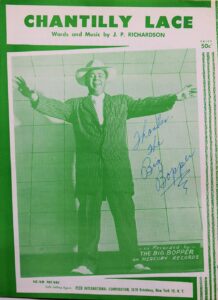 Between the unbearable cold, sleepless nights and lack of clean clothes (the guys were never in one town long enough to take care of the chore) Holly decided he’d had enough after their show in Clear Lake Iowa, and rented a private plane for $108 to fly he and his bandmates – guitarist Tommy Allsup and bassist Waylon Jennings (yep -THAT Waylon Jennings!) – to their next concert date in Minnesota. They even took everyone’s laundry with them on the plane.
Between the unbearable cold, sleepless nights and lack of clean clothes (the guys were never in one town long enough to take care of the chore) Holly decided he’d had enough after their show in Clear Lake Iowa, and rented a private plane for $108 to fly he and his bandmates – guitarist Tommy Allsup and bassist Waylon Jennings (yep -THAT Waylon Jennings!) – to their next concert date in Minnesota. They even took everyone’s laundry with them on the plane.
But then a serious of events took place – some understandable, some quirky – that led to disaster.
As the threesome were loading into a station wagon to drive to the airport just after midnight, Holly asked Jennings to run back into the Surf Ballroom to confirm they had all of their gear. Jennings ran into Richardson who had been battling a terrible cold, and agreed to let him ride on the plane instead. Jennings went to the car to retrieve his bag and tell Holly about the switch, and Holly joked that he hoped he would freeze on that bus. Jennings joked back that he hoped the plane would crash. A quip he would later regret.
 In the meantime, Valens had repeatedly asked Allsup if he could have the other seat on the plane, but was turned down. Worn down after Valens pleas, Allsup finally said he would flip a coin to see who got the last seat on the plane. Valens chose “heads,” and won the seat.
In the meantime, Valens had repeatedly asked Allsup if he could have the other seat on the plane, but was turned down. Worn down after Valens pleas, Allsup finally said he would flip a coin to see who got the last seat on the plane. Valens chose “heads,” and won the seat.
Just after 1 a.m. on February 3, 1959 in 15° weather, the three passenger Beechcraft Bonanza took off with Buddy Holly, 22; Ritchie Valens, 17; J. P. “The Big Bopper” Richardson, 28; and 21-year old pilot Roger Peterson. Though the pilot had been flying for four years, it was later thought that he didn’t have the experience necessary to fly into the oncoming blizzard conditions.
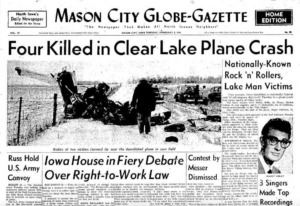
The aircraft crashed into a field five miles away.
In the 12 months before the plane crash the three musicians combined had sold over 10 million albums.
Buddy Holly and The Big Bopper were both Texans, and here are a few Lone Star State sites you can visit to celebrate their memory:
PORT ARTHUR
Museum of the Texas Gulf Coast
Among the exhibits in the halls of this museum is an impressive Music Hall that includes items from The Big Bopper’s career, and the Winter Dance Party tour.
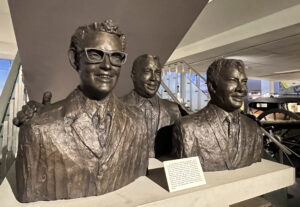
BEAUMONT
Forest Lawn Memorial Park Cemetery
LUBBOCK
Buddy Holly Center
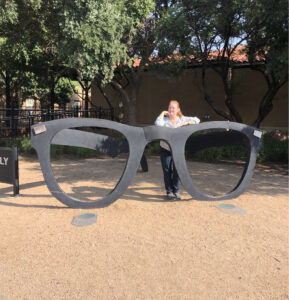 Large black Holly-style glasses and historical marker outside of the Buddy Holly Center, which contains the Buddy Holly Gallery and the most extensive collection of Buddy Holly artifacts in the world.
Large black Holly-style glasses and historical marker outside of the Buddy Holly Center, which contains the Buddy Holly Gallery and the most extensive collection of Buddy Holly artifacts in the world.
Eight and a half foot tall statue of the musician on
Cricket Street between 18th and 19th Streets.
Crickets Avenue (named after band Buddy Holly was in) and
glasses crosswalk at intersection of 18th Street.
Lubbock City Cemetery
As you enter the cemetery, follow signs to the resting place of Charles Hardin “Buddy” Holley. The the Holley was shortened to Holly for the stage.
Have you ever planned a trip around music history? Texas has plenty to offer!
Losing a Historical Treasure: Palacios’ Luther Hotel
 The phrase “seaside resort” brings to mind elegant escapes to the shore to listen to the waves break and take in the warmth of the sunshine. And people have been doing just that at The Luther Hotel in Palacios since it was bult in 1903.
The phrase “seaside resort” brings to mind elegant escapes to the shore to listen to the waves break and take in the warmth of the sunshine. And people have been doing just that at The Luther Hotel in Palacios since it was bult in 1903.
 The Luther Hotel holds a unique place in Texas history as well as in the hearts of generations of visitors and their families whose generations have stayed there across 100 years. It’s one of the few surviving Gulf Coast hotels built to attract tourists in the early 20th century.
The Luther Hotel holds a unique place in Texas history as well as in the hearts of generations of visitors and their families whose generations have stayed there across 100 years. It’s one of the few surviving Gulf Coast hotels built to attract tourists in the early 20th century.
Small towns started popping up in Matagorda County along the railroad lines that arrived in the area in the earliest part of the 20th Century– Blessing (see my Blessing post here), Van Vleck, Midfield, Cortes, Buckeye, Markham, Big Hill, and of course Palacios.
Victoria architect Jules Leffland designed the hotel, which was constructed by contractor D. D. Rittenhouse. Longleaf yellow pine for the framing and cypress for the siding were brought from Louisiana via Southern Pacific Railroad for the project. The Rittenhouse family and construction crews lived in tents on the land while the hotel was being constructed.
When the building was finished, it was named the Bay View Hotel and though it only had sixteen rooms, it was advertised as having accomodations for 100 guests. What we now see as the center section of The Luther was the original Bay View.
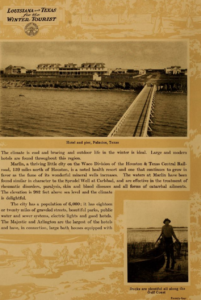
The number of visitors to Palacios grew exponentially in the next two years, enticed by “excursion rates” from the railroads and advertisements about the mild winters on the Texas coast. Yep, “Winter Texans” existed back then too.
In 1905, owners of the hotel decided to move it one half mile from its East Bay location to South Bay Boulevard to be closer to a new dance pavilion (also designed by Leffland) being built over the water. In order to do that, the original porches and chimney were removed and the structure was cut into three parts to be pulled by mule teams to its new location.
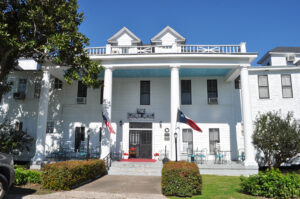 It was re-assembled and extended with east and west wings. That’s also when the 300-foot long porch, known as the “Longest Front Porch in Texas” were added.
It was re-assembled and extended with east and west wings. That’s also when the 300-foot long porch, known as the “Longest Front Porch in Texas” were added.
In addition, it acquired a dining room on the north side of the lobby, with a separate kitchen and a laundry building.
Such a grand place was worthy of a new name, and Hotel Palacios was chosen.
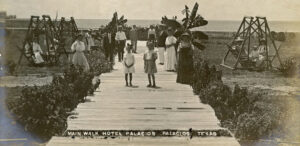 Thousands of visitors came to enjoy the surf bathing, warm weather, fishing, boating, lawn tennis and dancing on the pavilion. Meals in the dining room were served on Haviland china and silver, and a permanent orchestra provided music during lunch, dinner and for Sunday concerts.
Thousands of visitors came to enjoy the surf bathing, warm weather, fishing, boating, lawn tennis and dancing on the pavilion. Meals in the dining room were served on Haviland china and silver, and a permanent orchestra provided music during lunch, dinner and for Sunday concerts.
 A “Box Ball Alley” was built in 1913 that provided guests with alleys, pins and a ball to try their hand at a sport similar to bowling.
A “Box Ball Alley” was built in 1913 that provided guests with alleys, pins and a ball to try their hand at a sport similar to bowling.
Natural resources were used for the hotel, including water from an artesian well behind the structure piped into the building, and lighting was powered by gas generated on the land.
A string of owners and managers, some more conscious than other about upkeep of the property, maintained the hotel in the next few years though it remained a center of local social life.
 Charles and Elsie Luther purchased the run-down hotel in 1936 and undertook a massive renovation, which began with tearing down the old dining room and kitchen. The impressive porch was also removed, but its cypress lumber was saved and used as the foundation for an 11-room tourist court motel on the west side of the property.
Charles and Elsie Luther purchased the run-down hotel in 1936 and undertook a massive renovation, which began with tearing down the old dining room and kitchen. The impressive porch was also removed, but its cypress lumber was saved and used as the foundation for an 11-room tourist court motel on the west side of the property.
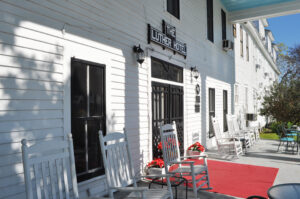 Five years later in 1941, the work was complete with structural strengthening, new wiring and plumbing and the installation of private bathrooms for each guest room. The breezeways between the central building and the east and west wings were enclosed, and a handful of rooms were turned into apartments for families of soldiers at Camp Hulen.
Five years later in 1941, the work was complete with structural strengthening, new wiring and plumbing and the installation of private bathrooms for each guest room. The breezeways between the central building and the east and west wings were enclosed, and a handful of rooms were turned into apartments for families of soldiers at Camp Hulen.
The historic hotel reopened to the public on April 20, 1941 (the owners’ 20th wedding anniversary) as The Luther Hotel. Since then it has survived many hurricanes, including Carla in 1961, as well as a severe fire in 1944.
The “stars were bright” at the Luther, too! Numerous celebrities stayed at The Luther while in the area doing shows at Camp Hulen, making movies or on press trips, including Shirley Temple, Rita Hayworth, Carole Landis, Artie Shaw, Harry James, Lyndon Baines Johnson (a family friend of Elsie Callaway Luther), actor John Schneider, and others.
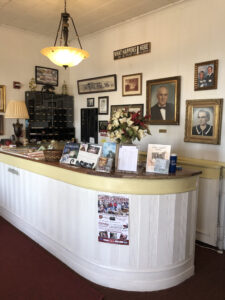 The sign at the front desk stated, “He who enters here is a stranger but once” and there were many who agreed. Throughout the 1970s and 80s the hotel often operated at full capacity, especially during the winter months when it became home for several Canadians and a Minnesota family who called it their winter home for twenty years.
The sign at the front desk stated, “He who enters here is a stranger but once” and there were many who agreed. Throughout the 1970s and 80s the hotel often operated at full capacity, especially during the winter months when it became home for several Canadians and a Minnesota family who called it their winter home for twenty years.
The Luther received its designation as a Recorded Texas Historic Landmark in 1965, over half a century ago. The United States Department of the Interior placed The Luther Hotel on the National Register of Historic Places in 2010.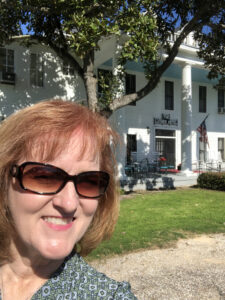
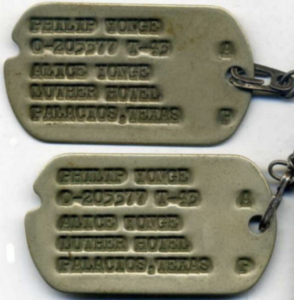 I visited the Luther on my birthday (January 12) in 2019, just months before the motor court wing that was built from the cypress of the original hotel porch was torn down, due to neglect. The manager was kind enough to show me a room filled with memorabilia from the hotels history. Autographed photos from celebrities, dog tags of soldiers from Camp Helen who used to live there, and even a letter from LBJ. I could have spent months combing through everything, and had hoped at one point to be able to return to do just that.
I visited the Luther on my birthday (January 12) in 2019, just months before the motor court wing that was built from the cypress of the original hotel porch was torn down, due to neglect. The manager was kind enough to show me a room filled with memorabilia from the hotels history. Autographed photos from celebrities, dog tags of soldiers from Camp Helen who used to live there, and even a letter from LBJ. I could have spent months combing through everything, and had hoped at one point to be able to return to do just that.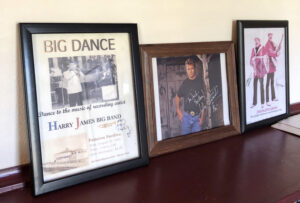
The hotel remained in the Luther family until the passing of Jack Findlay, the last family caretaker, in 2020. Surviving family members sold the hotel to the Ed Rachal Foundation from Corpus Christi, and the agreement states that the property must be demolished. The foundation is not interested in restoration.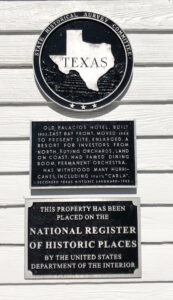
The Luther Hotel, which would have celebrated its 120th Anniversary this year will most likely not survive to celebrate that landmark.
If you are interested in expressing your views or concern over losing this piece of Texas history, you’re encouraged to contact:
Board of Directors, Ed Rachal Foundation, 555 N. Carancahua Street #700, Corpus Christi, Texas 78401
Or sign the online petition to save/repurpose the hotel at: https://www.change.org/p/save-the-luther-hotel-in-palacios-texas?source_location=topic_page
Let’s hope that we, as Texans, don’t continue to dismiss the importance of valuing and saving our history for future generations.
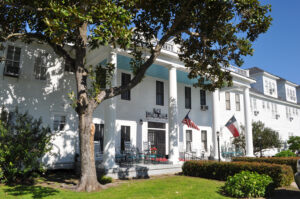
Juliff’s Diddy Wah Diddy Past
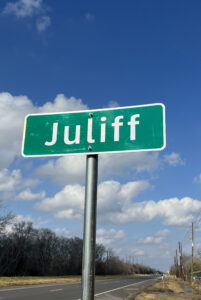 Ever see something that brings a song to mind? Well, back in the day when people saw the sign for Juliff Texas about 20 miles east of Richmond, they probably continued along singing a ditty about a diddy.
Ever see something that brings a song to mind? Well, back in the day when people saw the sign for Juliff Texas about 20 miles east of Richmond, they probably continued along singing a ditty about a diddy.
What? Well, like most things, there’s a story there.
In 1933 a few enterprising citizens opened a dance hall and several taverns right along the railroad line in town. The drinking, gambling and . . . well . . . working women . . . that followed made this little town a pretty rowdy place. But it helped them get through the Great Depression.
Inspired by the female professionals, a local musician wrote a song in 1934 called “Diddy Wa Diddy” that was supposedly about Juliff. In part it went, “I got a gal down in Diddy Wah Diddy. Ain’t no town an it ain’t no city.” Some even suggested changing the name of the town to Diddy Way Diddy (I kind of wish they had!), but that was probably after they’d enjoyed themselves a bit too much at the saloons.
Juliff, a shipping point on the Brazos River, was born on land that was originally part of the antebellum Arcola plantation. It was named for early settler John J. Juliff – “Triple J” to his friends. The town earned a post office in 1891 and by 1896 had its own general store. Business wasn’t steady in the community, and the post office closed in 1908 – only to reopen in 1914 and then – yup – close again in 1958
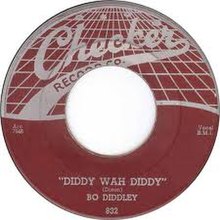 But what about the song? It was recorded by countless artists including Bo Diddley (which I guess would be Diddley’s version of Diddy) through the years.
But what about the song? It was recorded by countless artists including Bo Diddley (which I guess would be Diddley’s version of Diddy) through the years.
The playful wording was likely inspired by a 1929 tune by Arthur “Blind” Blake from Florida, whose song was also named Diddy Wah Diddy, but had different lyrics. It wasn’t the only time the phrase was “borrowed” for a song.
Here are a few of the words from Juliff’s own version:
“… I gotta gal down in Diddy Wah Diddy
(Diddy Wah)
Ain’t no town an it ain’t no city
(Diddy Wah)
She loves her man, just is a pity
Crazy ’bout my gal in Diddy Wah Diddy
… This little girl is sweet as she could be
(Diddy Wah)
I know she’s in love with me
(Diddy Wah)
A lovely face, she’s so pretty
(Diddy Wah)
But she’s still way down in Diddy Wah Diddy
… Ain’t no town, an it ain’t no city
But oh, how they love in Diddy Wah Diddy
… She kissed me all the time
(Diddy Wah)
She gonna turn me outta my mind
(Diddy Wah)
Anything, she says she’s ready
(Diddy Wah)
Run right back to Diddy Wah Diddy
(Diddy Wah)
(Diddy Wah)
(Diddy Wah)
(Diddy Wah)
… Ain’t no town, ain’t no city
Lord, how they love in Diddy Wah Diddy
… Diddy Wah
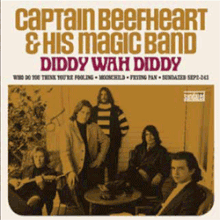 If you want to hear audio of the song, click HERE for a link to the 1960s version by Captain Beefheart and his Magic Band. Yes, really.
If you want to hear audio of the song, click HERE for a link to the 1960s version by Captain Beefheart and his Magic Band. Yes, really.
One of the lines of the song might hide a reason for the fate of the decline of Juliff: “Everybody would live in Diddy Wa Diddy – if only it wasn’t so hard to find.”
And that’s how the small town became connected with the jaunty tune. The next time you zoom through Juliff, hum a little diddy to let John Juliff you heard about the good old days in town.
Terlingua Cemetery: Ghost Town Graveyard

Welcome to Terlingua Cemetery, in Terlingua Texas.
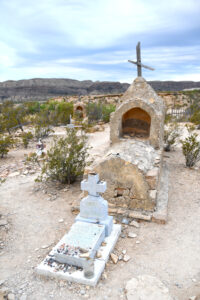 To those who are more accustomed to manicured cemeteries with vast green lawns, this place appears to be abandoned, but Terlingua cemetery is still in use today.
To those who are more accustomed to manicured cemeteries with vast green lawns, this place appears to be abandoned, but Terlingua cemetery is still in use today.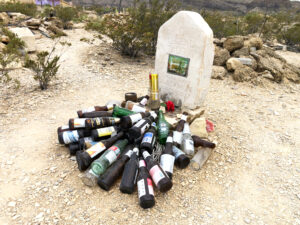
It’s one of the most photographed graveyards in the state of Texas, which should come as no surprise.
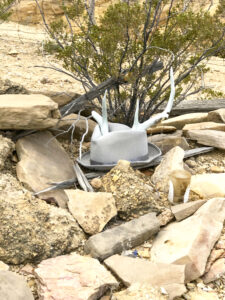 I’ve wanted to visit this amazing burial ground since I was a child, so to have the opportunity to roam through it – left alone with my thoughts and wonder about those who rest here – was a true privilege. There are the well-known, the unknown and the surprise of finding the grave of someone I knew personally in college. It was an astounding experience.
I’ve wanted to visit this amazing burial ground since I was a child, so to have the opportunity to roam through it – left alone with my thoughts and wonder about those who rest here – was a true privilege. There are the well-known, the unknown and the surprise of finding the grave of someone I knew personally in college. It was an astounding experience.
Terlingua was one of the most remote areas in North America at the time it was founded. It still remains set apart from more populated areas.
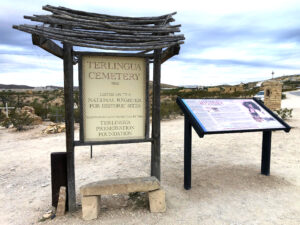 The cemetery encompasses one acre in the Terlingua Ghost Town – which isn’t really a ghost town at all. True . . . the town used to be the site of a quicksilver mining camp and place where desert folk called home beginning in the 1880s, but it’s now more of an artist community and a low key tourist base for visiting Big Bend National Park.
The cemetery encompasses one acre in the Terlingua Ghost Town – which isn’t really a ghost town at all. True . . . the town used to be the site of a quicksilver mining camp and place where desert folk called home beginning in the 1880s, but it’s now more of an artist community and a low key tourist base for visiting Big Bend National Park.
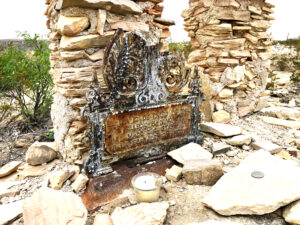 Marked graves date back to 1903, but burials began back when the dangerous process of mercury mining began here. Mine collapses, mercury poisoning and later influeza and tuberculosis epidemics populated the cemetery.
Marked graves date back to 1903, but burials began back when the dangerous process of mercury mining began here. Mine collapses, mercury poisoning and later influeza and tuberculosis epidemics populated the cemetery.
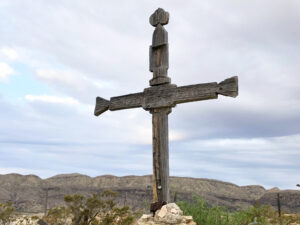 Conservative estimates say that there are about 400 burials in the cemetery: Men, women, and children. Miners, goat herders, artists, housewives, ranch hands, cooks, bootleggers, day laborers, war veterans, clergy, even murder victims. About 90 percent of those who rest here are of Hispanic heritage.
Conservative estimates say that there are about 400 burials in the cemetery: Men, women, and children. Miners, goat herders, artists, housewives, ranch hands, cooks, bootleggers, day laborers, war veterans, clergy, even murder victims. About 90 percent of those who rest here are of Hispanic heritage.
Those that were victims of mining accidents were sometimes laid to rest in coffins made by the companies they worked for.
Many of the gravesites have lost their markers, or they have simply become illegible over time. Some have all but vanished due to relentless weather and relic hunters.
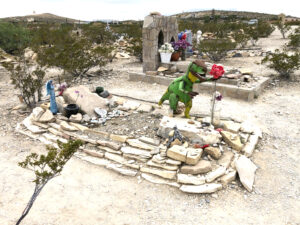 Others reflect the character and sometimes humor of those who they remember. A Hobbit hole, a metal T-Rex, and epitaph of “Another good man done gone.” They all lure visitors into slowing down to take in the silent stories of the cemetery.
Others reflect the character and sometimes humor of those who they remember. A Hobbit hole, a metal T-Rex, and epitaph of “Another good man done gone.” They all lure visitors into slowing down to take in the silent stories of the cemetery.
The Mining town was abandoned in the 1940s. That’s when Terlingua became a true ghost town . . . years before it became home to artists and others who tired of life in overcrowded communities . . . and eventually the visits of countless curious tourists on their way to Big Bend.
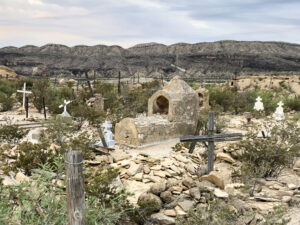 Visitors are fascinated by the variety of burial markers and folk art memorials, and of course – the stunning View of Chisos Mountains and Sierra del Carmens as a backdrop.
Visitors are fascinated by the variety of burial markers and folk art memorials, and of course – the stunning View of Chisos Mountains and Sierra del Carmens as a backdrop.
Each year an elaborate celebration takes place here to mark Dia de los Muertos, or Day of the Dead, giving the living a chance to honor and remember the departed.
Walking into Terlingua cemetery is like walking into a time warp. If a visit to this fascinating place doesn’t make a person stop and reflect . . . I’m not sure what would.
Join me for a stroll through the grounds of this historic cemetery in my Youtube video of the cemetery HERE.

